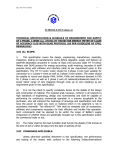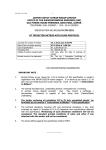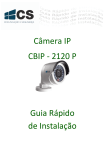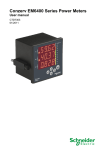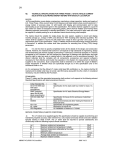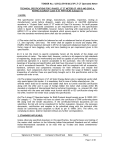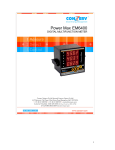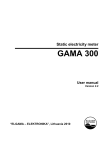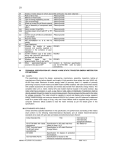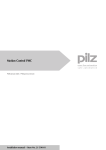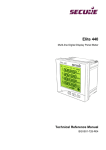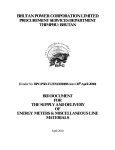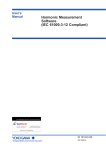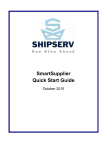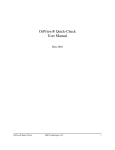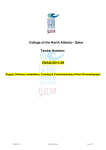Download SCHEDULE-III (Volume-A) - Jaipur Vidyut Vitran Nigam Limited
Transcript
Spec--HT LT TVM -1¬ SCHEDULE-III (Volume-A) TECHNICAL SPECIFICATION & SCHEDULE OF REQUIREMENT FOR SUPPLY OF 3 PHASE, 4 WIRE A.C. STATIC HT/LT TRIVECTOR ENERGY METER OF CLASS OF ACCURACY 0.5S WITH DLMS PROTOCOL (AS PER GUIDELINE OF CPRI, BENGALURU) 3.01 (A) SCOPE: i) This specification covers the design, engineering, manufacture, assembly, inspection, testing at manufacturers works before despatch, supply and delivery at site/FOR destination any where in vicinity of Class 0.5S accuracy static HT/LT Tri-vector Meters with DLMS protocol for energy accounting, audit metering, boundary & tariff purpose along with software and interface cable as per requirement given in this specification. The HT Tri-vector meter should be 3-phase 4-wire type suitable for connection to a 3 phase 4 wires as well as 3phase 3-wire system and the LT Tri-vector meter should be suitable for connection with 4th CT provided in neutral or without 4th CT in neutral circuit. The meter should be capable to record and display KWh, KVArh, KVAh and maximum demand in KVA for 3 phase 4 wire as well as 3 phase 3 wire AC balanced/unbalanced loads for a power factor range of zero (lagging) through unity up to zero (leading) as per requirement given in this specification. (ii) It is not the intent to specify completely herein all the details of the design and construction of material. The material shall, however, conform in all respects to high standards of engineering, design and workmanship and shall be capable of performing for continuous commercial operation in a manner acceptable to the purchaser, who will interpret the meanings of drawings and specification and shall have the power to reject any work or material which in his judgment is not in accordance therewith. The offered HT TVM shall be complete with all accessories, software and components necessary for their effective and trouble free operation. Such components shall be deemed to be within the scope of Bidder's supply irrespective of whether those are specifically brought out in this specification and/or the commercial order or not. (iii) The meter shall be ISI mark & bidder shall furnish the details of ISI license at the time of bid or or within 60 days from the date of opening of bid. B) REQUIREMENT As per MM wing. 3.02 STANDARDS APPLICABLE: Unless otherwise specified elsewhere in this specification, the performance and testing of the meters shall conform to the following Indian/International Standards and all related Spec--HT LT TVM -2- Indian/International standards to be read with up to date and latest amendments/revisions thereof: S. Standard No. No. 1. IS 14697-1999 (With latest amendments) 2. CBIP technical report No. 304. 3. IEC 62053-22-2003 IEC 62052-11-2003 CBIP Technical Report Revised July 1996 IS: 9000 Title : Specifications for AC Static Transformer Operated Watt-hour and VAR-Hour Meters, class 0.2S & 0.5S. : Specification for AC Static Electrical Energy Meters. With latest amendments. : AC Static Watt-hour Meters for Active Energy, class 0.2S & 0.5S 4. No.111 : Specification for Common Meter Reading Instrument. : Basic Environmental Testing Procedures 5. for Electronic & Electrical items. 6. IEC 62056(DLMS/ COSEM) : Open protocol standard for communication of meter datas. 7. IS: 15707 :Testing, Evalution, Installation and maintenance of AC Electricity metersCode of Practice Meters matching with requirements of other national or international standards, which ensure equal or better performance than the standards mentioned above, shall also be considered. When the equipment offered by the tenderer conforms to standards other than those specified above, salient points of difference between standards adopted and the standards specified in this specification shall be clearly brought out in the relevant schedule and copy of such standards along with their English translation shall invariably be furnished along with the offer. 3.03 CLIMATIC CONDITIONS: The meters to be supplied against this specification should be capable of performing and maintaining required accuracy under extreme hot, cold, tropical and dusty climate and solar radiation typically existing in the state of Rajasthan (India). The meter shall be required to operate satisfactorily and continuously under the following tropical climate conditions: a) Maximum ambient air temperature b) Maximum ambient air temperature in shade c) Maximum temperature attainable by the meter exposed to Sun. d) Minimum ambient temperature in shade e) Average daily ambient air temperature f) Maximum relative humidity. g) No. of months of tropical monsoon condition h) Maximum attitude above mean sea level i) Average rain fall. j) Maximum wind pressure k) Isoceranic level (days/ year) l) Seismic level ( Horizontal Accn.) m) Permitted noise level : 50o C : 45o C : 60 o C : (-) 5 o C : 40 o C : 95%. : 4 Months. : 1000 Meters. : 10-100 cms. :200Kg/ Sq. meter. : 40 : 0.30 g. : 45 db. Spec--HT LT TVM -3- 3.04 SUPPLY SYSTEM: Rated Voltage (Vref) (For HTTVM) (Through PT) Rated Voltage (Vref) (For LTTVM) 3 x 63.5 V - Phase to Neutral (3 phase 4 wire system) 3 x 110 V - Phase to Phase Meter shall be programmed for PT ratio 11KV/110V (Ph.to Ph.) 3 x 240 V - Phase to Neutral (3 phase 4 wire system) 3 x 415 V - Phase to Phase Rated current (Ib) (Connected through CT) 3 x -/5 Amps Multiplying factor to arrive at actual primary values wherever applicable shall be calculated from the CT and PT ratio of the installed CTs and PTs/CT ratio of the installed CT’s. 3.05 POWER FACTOR RANGE: The meter shall be suitable for full power factor range from zero (lagging) through unity to zero (leading). The meter should work as an active energy import and export and reactive (lag and lead) energy meter. 3.06 POWER SUPPLY VARIATION: The supply system shall be 3x110V Phase to Phase,3 phase 4 wires. The extreme power supply variations for which an operating meter should withstand without damage and without degradation of its meteorological characterstatics when it is subsequently operated under its normal operating conditions shall be as follows: Specified operating range - 0.8 to 1.15 V ref. Limit range of operation - 0.7 to 1.20 V ref. Frequency - 50 Hz. +/- 5% However, the bidder can offer meter, which can withstand higher variations. The limit of power supply variations should be as per IS: 14697-1999. 3.07 ACCURACY: Class of accuracy of the meter shall be 0.5S. The accuracy should not drift with time. 3.08 POWER CONSUMPTION: (i) Voltage circuit: The active and apparent power consumption in each voltage circuit including the power supply of meter at reference voltage, reference temperature and reference frequency shall not exceed 1.0 Watt per phase and 8 VA per phase respectively. (ii) Current circuit: The apparent power taken by each current circuit at basic current, reference frequency and reference temperature shall not exceed 1 VA per phase. Spec--HT LT TVM -4- 3.09 STARTING CURRENT: The meter should start registering the energy at 0.1% Ib and unity power factor. 3.10 MAXIMUM CURRENT: The rated maximum current of the meter shall be 200% Ib. 3.11 GENERAL AND CONSTRUCTIONAL REQUIREMENTS: i) Meters shall be designed and constructed in such a way so as to avoid causing any danger during use and under normal conditions. However, the following should be ensured: a) b) c) d) e) f) Personnel safety against electric shock Personnel safety against effects of excessive temperature. Protection against spread of fire. Protection against penetration of solid objects, dust and water. Protection against fraud. Protection against Pilferage. ii) All the materials and electronic power components used in the manufacture of the meter shall be of highest quality and reputed make to ensure higher reliability, longer life and sustained accuracy. iii) (a) The manufacturer should use application specific integrated circuit (ASIC) for metering functions. (b) The meter should not have any form of mechanical adjustment such as trim-pots, potentiometer etc. for calibration. The meter shall be factory calibrated and no adjustment of calibration shall be possible at site by any means. (c) The electronic components shall be mounted on the printed circuit board using latest Surface Mount Technology (SMT). The PCB material should be made of glass epoxy FR-4 grade conforming to relevant standards or better grade. iv) All insulating materials used in the construction of meters shall be non-hygroscopic, nonageing and of tested quality. All parts that are likely to develop corrosion shall be effectively protected against corrosion by providing suitable protective coating. v) The meter shall have test out put device in the form of calibrating LED accessible from the front and capable of being monitored conveniently with suitable testing equipment. vi) The meter shall conform to the degree of protection IP 51 of IS: 12063/IEC: 60529 for protection against ingress of dust, moisture and vermin. vii) The meter shall be immune to tampering through application of external magnetic field (A.C. electro-magnet or D.C. magnet) as per the value specified in CBIP technical report 88 (with latest amendments). However the meter alone should comply up to 0.27 Tesla Magnetic field with a permanent magnet. viii) The meter should continue to function even if any spurious signals are injected on the neutral of the meter such as D.C signals through diodes etc. and /or High Frequency Signals. Spec--HT LT TVM -5- ix) The meter shall be supplied with a transparent extended terminal-block cover (ETBC). x) The meter shall have two push buttons, one for forward scrolling and other for reverse scrolling of different parameters available in push button mode. xi) Meter Base And Cover: (a) The meter -base, meter cover; terminal block and ETBC shall be made of unbreakable, high grade, flame retardant polycarbonate with thickness more than 2.0 mm, and of good dielectric and mechanical strength. The material of meter base & terminal block shall be glass reinforced. (b) The colour of meter shall be orange. (c) Meter cover and extended terminal block cover (ETBC) should be injection moulded in UV stabilized polycarbonate in natural colour. The ETBC shall be kept fully transparent and the meter cover except the window portion shall be semi-transparent / non-transparent/corrugated. The moulded meter case and terminal cover(s) should not change in colour, shape, size, and dimensions, when subjected to 200 hours on UV ageing test. It should withstand 650 deg. C glow wire test and heat deflection test as per ISO 75. (d) The manufacturer shall emboss on the base/cover(s), the name of the material they have used in an abbreviated form e.g. PCFR 10 GF (to denote that they have used polycarbonate flame retardant 10 % glass filled polycarbonate). (e) The window portion shall be of transparent, unbreakable, silicon coated, scratch resistant surface UV stabilized polycarbonate material for easily reading all the displayed values/parameters, nameplate details and calibrating LED. It should not fade in course of time and become opaque causing inconvenience in reading. The window portion shall be ultrasonically welded with the meter cover such that it cannot be removed undamaged without breaking the cover. (f) The meter cover shall be ultrasonically welded with the meter base. The sample meter to be sent along with bid may not be ultrasonically welded with the meter base, as at the time of sample testing it has to be opened to ascertain conformity of meter as per specification. However, before commencement of supply, sample has to be got approved with ultrasonically welded meter by the successful bidder xiii) Terminal Block: (a) The detachable terminal block shall be moulded type made of non-hygroscopic, flame retardent material having good dielectric and mechanical strength. The moulded terminal block shall be made from best quality phenol formaldehyde or 10-20% glass filled polycarbonate material or any equivalent/better material conforming to FH-1 of IS 11731 (Part-I) having adequate insulating properties and mechanical strength with brass inserts for connecting terminals. The terminal block should satisfy all the conditions specified in IEC-62052 & IS14697 and shall be made from best quality phenol formaldehyde or 10-20% glass filled Spec--HT LT TVM -6- polycarbonate material or any equivalent/better material. The glass filled polycarbonate should fulfill the requirement of following tests (i) The flame retardant rating of VO as per UL94 testing. (ii) The glow wire temperature of 960 deg. C as per IS-11000 (part-2/Sec-1) or IEC 695-2-1. (iii)Heat deflection temperature (HDT) test of 135 deg. C. (iv) Ball pressure test at 125 deg. C. (b) The terminal block, the ETBC and the meter case shall ensure reasonable safety against the spread of fire and shall not be ignited by the thermic overload of live parts in contact with them c) The current circuit conductors of a meter shall be connected to its current terminals inside the meter terminal block adopting procedure prescribed either B-1 or B-2 of the recommended methods under Clause 6.4-Annexure-B of IS 14697. Any other method which meets this requirement in a better manner/way shall also be considered. The bidder should elaborate the arrangement adopted. (d) The meter terminal block shall have tin- plated brass terminals. The terminals shall have suitable construction with barriers and transparent cover to provide firm and safe connections of incoming and out going leads. The terminal screws shall have flat bottom so as not to pierce in the external conductors. The terminals shall be of suitable rating to carry continuously Imax current and made of electroplated (or tinned) brass and shall be of replaceable type. Any other provision which meets this requirement in a better manner/ way shall also be considered. The bidder should elaborate the procedure adopted. (e) (i)The manner of fixing the external conductors to the terminal block shall ensure adequate and durable contact such that there is no risk of loosening or undue heating. Screw connections transmitting contact force and screw fixings, which may be tightened and loosened several times during the life of the meter, shall screw into the body of brass terminal. All parts of each terminal shall be such that the risk of corrosion is minimized. Two screws shall be provided in each current terminal for effectively clamping the external leads or thimbles. Each clamping screw shall engage a minimum of three threads in the terminal. The ends of screws shall not pierce and cut the conductors used. Electrical connection shall be so designed that contact pressure shall not be transmitted through insulating materials. If the manner of fixing of terminals is through thimbles /lugs/reducer type terminals. The supplier shall supply a set of the same along with each meter. (ii) The internal diameter of the terminal hole shall be minimum 4.0mm. The holes in the insulation material of the terminal block, which form an extension of the terminal holes, shall be of sufficient size to accommodate the insulation of the conductors also. The clearance and creepage distance shall not be less than the values specified in clause 6.6 of IS 14697:1999. Further, the supporting webs between two terminals of the terminal block should be sufficiently high to ensure that dust does not bridge the two neighboring terminals or a flash over does not take place. f) The fixing screw(s) used on the ETBC for fixing and sealing of extended terminal cover shall be held captive on the terminal cover. Spec--HT LT TVM -7- g) To facilitate sealing, a raised support arrangement with minimum 2 mm hole nearby sealing screws, which shall constitute an integral part of the terminal cover or a slot type arrangement underneath/alongside the sealing screw shall be provided. xiv) The termination of current circuit wires inside the meter (i.e. CT primary conductor) on the terminal block shall be through lugs and washers of proper size. The loop length of the primary current circuit should be kept minimum. Alternatively the CT primary conductor may be flattened to form a ‘lug’ like shape for proper termination on terminal block without using lug or any other better arrangement may also be provided. xv) The meter shall have minimum three fixing holes, one at the top and other two inside the terminal block. The top hole shall be key-hole type on the back of the meter base so that the hanging-screw is not accessible after fixing of the meter and it shall not be possible to remove the meter from the hanging-screw without removing the terminal cover and screw(s) from the terminal block. Any alternate better arrangement shall also be considered for acceptance. The lower fixing holes shall be provided under the extended terminal cover. A set of fixing screws shall be supplied with each meter. xvi) Extended terminal block cover shall be provided to ensure that the internal parts are not accessible for tampering etc. without breaking the seals. The ETBC shall be extended by about 30 mm± 5 mm below the terminal block. A firm connection shall be established with in the meter case to energies the voltage circuit. Arrangement for display, optical port, auxiliary supply source, push buttons for manual mode, meter nameplate and display sequence should be made in such a manner that it is accommodated in size of 170mm(W) x 140 mm (H) from opposite side of ETBC. This is required for facilitating of fixing of the HT /LT Tri-vector meter in HT/LT panel box. 3.12 MANUFACTURING ACTIVITIES: i) The meter should employ latest technology such as Application Specific Integration Circuit (ASIC) to ensure reliable performance. The mounting of component on the PCB (Printed Circuit Board) must be SMT (Surface Mounted Technology) type by deploying the automatic SMT pick and place machine and reflow soldering process. The electronic component used in the meter shall be of high quality such that the meter shall remain in the accuracy class for at least up to 10 years. Further, the Bidder should own or have assured access (through hire, lease or subcontract) of above facilities. ii) Quality should be ensured at the following stages: a) At PCB manufacturing stage, each board shall be subjected to computerised bare board testing. b) At insertion stage, all components should under go computerised testing for conforming to design parameters and orientation. c) Complete assembled and soldered PCB should under go functional testing using Automatic Test Equipments (Testing Jig) d) Prior to final testing and calibration, all electronic components of the meter shall be subjected to accelerated ageing test to eliminate infant mortality. iii) The calibration of meters shall be done in house. Spec--HT LT TVM -8- iv) The bidders should submit the list of all major components used in meter along with the offer. v) A detailed list of bought-out items, which are used in the manufacture of the meter, should be furnished indicating the name of firms from whom these items are procured. The bidder shall also give the details of quality assurance procedures followed by him in respect of the bought-out items. 3.13 SEALING ARRANGEMENT OF THE METER: Atleast two sealing screws shall be provided for proper fixing of meter cover so that access to the working parts shall not be possible without breaking the seals. One screw provided on left side shall be used by manufacturer to provide his own sealing with high quality double anchor polycarbonate seal bearing laser etched monogram of JVVNL along with meter serial number and other provided on right side by purchaser, which should be left unsealed. Provision shall also be kept for one no. seal on terminal cover. All the sealing screws shall be captive type so that they cannot be detached when they are in open condition. The holes in the head of sealing screw shall be of min. 2mm dia. The sealing screws for meter base and cover shall be unidirectional and slotless (2 No.) .Two No. tamper indicative paper seal(s) on either side of the meter case shall be provided by the manufacturer. For this, at least two (2) Nos. seals on meter body and provision for, one (1) no. seal on meter terminal cover and one (1) no. seal on communication port shall be provided. For the above sealing arrangement for the purchaser, the manufacturer shall provide at least one seal on the meter body at the factory after calibration and testing. Provision for all the seals should be provided on front side only. Rear side sealing arrangement will not be accepted. The Suppliers in their offer should explain the sealing arrangement. 3.14 MARKING OF METER: The meter terminal marking and mounting arrangement should be as per Indian installation practices. The marking on every meter shall be in accordance with IS 146971999/ IEC 62052-11-2003 and annexure A-5.1 of the guideline issued by CPRI, Banglore. Every meter shall have nameplate beneath the meter cover such that the nameplate cannot be accessed without opening the meter cover and without breaking the seals of the meter cover and the nameplate shall be marked indelibly. The nameplate marking should not fade or otherwise be adversely affected by UV exposure with lapse of time. 3.15 CONNECTION DIAGRAM & TERMINAL MARKINGS: The connection diagram of the meter shall be clearly shown for 3 phase 4 wire system as well as 3 phase 3 wire system/ with or without installation of 4th CT in neutral line, on inside portion of the terminal cover and shall be of permanent nature. The meter terminals shall also be marked and this marking should appear in the above diagram. 3.16 SOFTWARES AND INTERFACE BETWEEN METER & HHU: Adequate number of licensed copies of the following software shall be made available and shall be installed in HHU and Base Computer System (BCS) by the Supplier without extra cost. The Supplier shall impart necessary training regarding installation and use of the Spec--HT LT TVM -9- above softwares. The exact quantity of each type of software to be so supplied shall be intimated to the Supplier prior to/at the time of ordering subject to maximum 30 Nos./sets. i) Software for reading, down loading meter data, as well as configuration change activity in meter such as time setting, reactive energy for apparent energy calculations reprogramming, MD integration period change and TOD reprogramming (changing TOD time-zones, subject to maximum 8 time zones, and/ or, change of any one or more TOD time-zone timings in the meter), normally resident in the Hand Held Unit (HHU); Software suitable for MS Window XP or higher version. The software shall be installed in and be compatible to all makes of the HHUs (Analogic/Sands/any other make) and PC/Laptop as well as supplied separately in the form of floppies/CDs. ii) Configuration change activity (programming) should be enabled at BCS under multilevel password protected security system for specified/selected meter(s) identified by the meter serial number(s). Configuration change activity can only be possible after written consent of SE(M&P), JVVNL, Jaipur and a password available with SE(M&P) Jaipur is to be entered first for enabling any configuration change activity. Without entering the password provided by SE(M&P) Jaipur, configuration change activity shall not at all possible. Such configuration change in the meter shall be immediately preceded automatically by meter-data reading such that entire meter data prior to change is downloaded from the meter before the change is effected in the meter. Details of minimum 10 such change/s (event/s) made in the meter shall be logged in the meter memory, each with date and time-stamp, and shall be capable of downloading through HHU and shall be available for viewing at the BCS end. The logging shall be roll-over type on first-in, first-out basis. iii) The time taken for downloading the complete meter data should not be more than Five minutes. Any future up gradation made by the supplier in any of the above softwares shall also be provided free of cost. (a) Platform: The BCS should be executable on MS WINDOWS 95/98/2000/XP/VISTA or higher operating system. The BCS shall be suitable to run on IBM PC or compatible hardware platform. (b) Meter Data Display: i) The BCS should show electrical conditions existing at the time of reading the meter in tabular forms as well as in graphical format (Phasor diagram). ii) All the information about energy, maximum demand and their respective TOD register readings, billing register readings and billing history readings should be shown in a manner which user can understand quickly, preferably in tabular format. iii) All the load survey data should be available in numerical as well as graphical format. It should also be possible to view this data in daily, weekly and monthly formats. The load survey graph should show values where the cursor/pointer is placed for the selected or all parameters. Spec--HT LT TVM - 10 - iv) All the information about tamper events should be accompanied with date and time stamping along with the ‘snap-shots’ (details) of the respective electrical conditions. This information should be displayed in the sequence in which it happened, in cumulative format as well as in summary format. The cumulative format should segregate a particular tamper information and summary report shall show count of tamper occurrence and the duration for which meter has remained under tamper condition. v) The BCS should be capable of preparing all available makes of HHUs to read the meter information or for Configuration Change activity in the meter after entering the password provided by SE(M&P) Jaipur such as time-setting, Reactive Energy for Apparent Energy calculation re-programming, MD integration period change and TOD re-programming (changing TOD time-zones, subject to max. 8 time-zones, and/or, change of any one or more TOD time-zone timings in the meter). (c) Support Display: There should be "user friendly" approach for viewing meter data for the reading collected now or for the reading collected in the past. All information about a particular consumer should be segregated and available at one place so that locating any consumer's past data is easy. It should be possible to locate/retrieve data on the basis of one of the following particulars: i) Consumer ID/Number. ii) Meter Sr. No. iii) Date of meter reading. iv) Location. (d) The Data Transfer: It should be possible to transfer the data to and from HHU through serial interface/port. The data transfer shall be in the desired format, which suits to billing software of the Nigam. (f) Security: The BCS shall have multi level password for data protection and security. The first level shall allow the user to enter the system. The different software features shall be protected by different passwords. The configuration of passwords shall be user definable. The software installed on one PC shall not be copiable on to another PC. 3.17 SALIENT FEATURES: The meter shall have the following additional salient features: i) It should be possible to check the healthiness of phase voltages by displaying all the voltages on the meter display. ii) The meter display shall have phase indicators to indicate the status of phase voltages, which shall keep coming with every display. iii) The meter should work accurately irrespective of phase sequence of the mains supply. Spec--HT LT TVM - 11 - iv) It should be possible to check the correctness of connections of CT and PT to the meter with proper polarity. This shall be made available on HHU by displaying phasor diagram. For this purpose, a suitable software for field diagnosis of meter connections with the help of meter and HHU should be supplied as per Annex G15 of IS 14697/ 1999. v) The meter should remain powered up and functional even when either of any two phases or any one-phase alongwith neutral is available to the meter. vi) The meter should continue to record accurately as per prevailing electrical conditions even if the neutral of potential supply gets disconnected. vii) The meter shall be provided with adequate magnetic shielding so that any external magnetic field (AC Electro Magnet or DC Magnet as per the values specified in CBIP Technical Report No.88, with latest amendments) applied on the meter shall not affect proper functioning and recording of energy as per error limits prescribed by CBIP.However the meter alone should comply up to 0.27 Tesla D.C magnetic field. On application of 0.27 Tesla DC magnet at anywhere on meter body, the meter shall record energy at Imax, rated voltage and unity power factor as per CBIP / IS, in case of Magnetic Interference beyond 0.27 Tesla and the event of Magnetic Interference and restoration shall be available with date & time stampings along with other snap shots. viii) Meter shall have Scroll Lock facility to display any one desired parameter continuously from display parameters, which will keep on displaying till the lock is released. ix) The meter should continue to function even if any spurious signals are injected on the neutral of the meter, such as D.C signals through diodes etc. x) The meter reading count should increase by one digit every time the meter is read successfully through HHU or computer or any other device and be available at BCS end as well as on meter display. The count shall not increase through HHU operations as instantaneous parameters view and other similar HHU operations, which do not download any data from meter memory. xi) Data Alteration Count: Meter should be capable to display the data alteration count This count should increase by one digit whenever there is any programme or meter data change in the meter through HHU or computer or any other device and be available at BCS end as well as on meter display. This count should not increment on any data read-only communication. xii) The meter shall be capable of detecting condition of power-off if mains supply is not present. It shall record such occurrence and restoration of power failures as separate events in the meter memory with date and time stamp. Snapshot of electrical parameters is not necessary during this condition. xiii) The meter shall have provision to be read in the absence of power through an external /internal source as per provision of Annex G14 of IS 14697/1999 such that it should not be possible to damage the internal circuitry of the meter by applying any voltage on /through the device /port provided for powering up the meter in the absence of power supply. The bidder should explain the method adopted by them for this purpose in their offer. Minimum 20 such events (either off or on) shall be logged in meter memory and be available for downloading through a CMRI for viewing at the BCS end. These events shall be logged in Spec--HT LT TVM - 12 - a separate compartment on roll-over, first-in, first-out basis. Electrical values snap shots shall not be required for the logging of Power -off / Power - on events. xiv) The LTTVM shall record active/apparent more CT’s are reversed. The current vector positive(import) for the computation of 3 phase main active (import) energy register and KVAh and lead energy. energy in forward direction even if one or direction shall always be considered as active energy, which shall be added in the computation shall be based on reactive lag xv) The meter should be compatible to GSM/GPRS/CDMA technology for remote metering. xvi) The meter should be compatible to data exchange for electricity meter reading/tariff/load control as per guideline specification of CPRI, Banglore (Enclosed). 3.18 DISPLAY OF MEASURED VALUES: The measured value(s) shall be displayed on seven segments, seven digits Liquid Crystal Display (LCD) display unit/register; having minimum character height of 8 mm. LCD to be of ‘STN’ (super tested kneumatics) type construction suitable for temperature 70 Deg.C continuously. The data should not be lost in the event of power failure and should be stored in nonvolatile memory. The non-volatile memory should retain data for a period of not less than 10 years under un-powered condition i.e. the non-volatile memory shall have a storage life (without use) of ten (10) years. Battery backup memory will not be considered as NVM. It should be possible to easily identify the single or multiple displayed parameters through symbols/legend on the meter display itself or through display annunciator alongwith a separate legend plate fixed on the front face of the meter cover. The register shall be able to record and display starting from zero, for a minimum of 1500 hours, the energy corresponding to rated maximum current at reference voltage and unity power factor. The register should not roll over in between this duration. 3.19 METER SERIAL NUMBER: In addition to providing serial number of the meter on the display plate, the meter serial number shall also be programmed into meter memory for identification through HHU/meter reading print out. 3.20 DISPLAY SEQUENCE: “The meter shall display the required parameters as per guideline document issued by CPRI, Banglore. Spec--HT LT TVM - 13 - (A) QUANTITIES TO BE MEASURED & DISPLAYED The meter shall be capable of measuring and displaying the following electrical quantities within specified accuracy limits for polyphase balanced or unbalanced loads: a) Instantaneous Parameters such as phase and line voltages, currents, power factors, overall kVA, kW, kVAr, power factor, frequency etc as per details given in the table below and enclosed annexure. b) Block Load Profile Parameters such as kVAh/kWh/kVArh (lag/lead)/Maximum Demand (MD) in kW/kVA/power factor/phase and line voltages/currents etc (minimum 5 parameters) as per details given in the table below and enclosed annexure. c) Daily Load Profile Parameters such as cumulative energy kWh (import/export)/cumulative kVAh (while kW- import/export)/cumulative energy kVArh as per details given in the table below and enclosed annexure. In addition to above the meter shall also record the Name plate details, programmable parameters (readable as profile), occurrence and restoration of tamper events along with the parameters (Table A5.1, A5.2 and A6.1 to A6.8 respectively of enclosed guideline document) Detail of category wise parameters requirement suitable for specific location such as feeder/DT metering, interface points/boundary points is given in following tables of guidelines document enclosed as annexure: (As per guideline of CPRI, Banglore). Category Substation Feeder/ Distribution Transformer meter Boundary/Ring fencing/Interface Meters HT Consumer Meters Parameter group Instantaneous parameters Block Load Profile parameters Instantaneous parameters Block Load Profile parameters Daily Load Profile parameters Instantaneous parameters Block Load Profile parameters Billing Profile parameters Name Plate details Programmable Parameters Event Conditions Annexure Table No. A2.1 A2.2 A3.1 A3.2 A3.3 A4.1 A4.2 A4.3 A5.1 A5.2 A6.1 to A6.7 Substation Feeder/ Distribution Transformer/Boundary/Ring fencing/Interface/HT Consumer Meters Logging parameters for each of the Capture parameters for event A6.8 event condition – shall be selected as applicable (Event Log Profile) (B) DEMAND INTEGRATION PERIOD The maximum demand integration period may be set at 15 minute or 30 minute. (C) MD RESET It should be possible to reset MD by the following: a) Auto reset at 24:00 hrs at the end of each billing cycle . (D) COMMUNICATION CAPABILITY The meter shall be provided with two ports for communication of the measured/collected data as per guideline document enclosed in the annexure, i.e. a hardware port compatible with RS 232 or RS 485 specifications which shall beused for remote access through suitable Modem GPRS/CDMA) and an Optical port complying with hardware specifications detailed in IEC- Spec--HT LT TVM - 14 - 62056-21. This shall be used for local data downloading through a DLMS compliant HHU. The RS 485 port shall be used at Substations suitable for multi-drop connections of the meter for exporting data to sub-station data logger/DCU/Computer and the remote end server. The RS 232 port shall be used at boundary points meters and Distribution Transformer meters capable to transfer and export data to the remote end server through suitable communication mediums (GPRS/CDMA). Both ports shall support the default and minimum baud rate of 9600 bps. (E) HAND HELD UNIT (HHU) To enable local reading of meters data a DLMS compliant HHU shall be used. The HHU shall be as per specification given in the enclosed guidelines document. It shall be compatible to the DLMS compliant energy meters that are to be procured/supplied on the basis of this specification. The HHU shall be supplied by the meter manufacturer along with the meter. Numbers of HHU to be procured shall be decided by the purchaser. (F) TAMPER & FRAUD MONITORING FEATURES The meter shall work satisfactorily under presence of various influencing conditions like External Magnetic Field, Electromagnetic Field, Radio Frequency Interference, harmonic Distortion, Voltage/Frequency Fluctuations, and electromagnetic High Frequency Fields etc. The meter shall be immune to abnormal voltage/frequency generating devices and shall record the occurrence and restoration of such tamper events along with parameters such as current, voltages, kWh, power factor, event code, date & time etc. (listed in Table A6.1 to A6.7 in enclosed document). Tamper details shall be stored in internal memory for retrieval by authorized personnel through either of the following: i) HHU. ii) Remote access through suitable communication network. Minimum 200 numbers of events (occurrences & restoration with date & time) should be available in the meter memory. 3.21 OUT PUT DEVICE: The meter shall have a test output accessible from the front and be capable of being monitored with suitable testing equipment. The operation indicator, if fitted, must be visible from the front. Test output device shall be provided in the form of one common LED for kWh, kVArh and optionally kVAh with the provision of selecting the parameter being tested. Alternatively, test output device in the form of separate LEDs for kWh, kVArh and optionally kVAh is also acceptable. The relation between test output and the indication on display shall comply with the marking on the name plate (imp per kWh/kVArh/kVAh). The bidder shall state the necessary number of pulse count(s) to ensure measurement accuracy of at least 1/10th of class of the meter at the different test points. The resolution of the test output pulse(s) should be sufficient to enable conduction of the starting current in less than 10 minutes and accuracy test at the lowest load with desired accuracy within 5 minutes. Spec--HT LT TVM - 15 - 3.22 AUXILIARY POWER: The auxiliary power shall be drawn from all the three phases and the meter should be able to remain powered up with availability of any two phases or any one phase and neutral. Alternative power packs one percent of ordered quantity for taking reading during power down conditions shall be supplied free of cost. 3.23 (A) MAXIMUM DEMAND (MD) REGISTRATION: The meter shall continuously monitor and calculate the average demand in KVA during the integration period set and the maximum, out of these, shall be stored along with date and time when it occurred in the meter memory. The maximum registered value shall also be made available on meter-display. The maximum demand will be computed from the main apparent energy register. The rising demand under the current integration period should be displayed alongwith the elapsed time. The integration period shall be set as 30 minutes, on real time basis starting from 00.00 H The principle of maximum demand calculation used by the Bidder should be explained in the offer. 3.23 (B) Maximum Demand Registration and MD resets : Meter shall continuously monitor and calculate the average maximum demand of each demand interval time of 15/30 minutes on real time basis and maximum of these in a calendar month shall be stored. The maximum demand shall automatically reset at 24.00 hrs. of the last date of each calendar month for which minimum 30 years calendar shall be programmed by the manufacturer. The cumulative kWh should also be recorded at 24.00 hrs. on the last date of each calendar month for previous 6 months. 3.24 MAXIMUM DEMAND RESET: The auto reset facility of MD at pre-defined date & time shall be provided. The meter shall log on in the meter memory, average value of voltage & current for 15/30 minutes integration period, the maximum demand reset count, which should increment by one digit every time the MD is reset. 3.25 LOAD SURVEY CAPABILITY & BILLING POINT REQUIREMENTS: As per the guideline issued by CPRI, Banglore. 3.26 HARMONICS MEASUREMENTS: The accuracy of the meter shall not be affected by harmonics circulating in the system of magnitudes within permissible limits stipulated in relevant ISS/ IEC/ CBIP Standards and CEA Regulations-2004. The meter shall indicate and record the total resultant quantities of fundamental frequency and harmonics or alternatively the meter shall record fundamental frequency quantities and harmonics related quantities (such as KWh, KVAh and KVARh) separately. Spec--HT LT TVM - 16 - “The meter shall comply with the provisions of IS: 14697/1999 and shall be capable of measuring 50 Hz energy and total energy. In this case, meter shall indicate mechanism of 50Hz energy measurement, sampling rate, accuracy of current measurement under the presence of harmonics. Alternatively meter shall comply with IEC 62053-22:2003 and shall be capable of measuring total energy consisting of fundamental energy and harmonics energy. In this case percentage distortion due to harmonics should be available in the graphics. The fundamental and total energy shall be logged in the meter memory and be capable of downloading to the BCS through the HHU and be available for viewing at the BCS end. 3.27 SELF DIAGNOSTIC FEATURE: The meter shall be capable of performing complete self-diagnostic check to monitor the circuits for any malfunctioning to ensure integrity of data memory location all the time. The meter shall have indications for unsatisfactory / nonfunctioning / malfunctioning of the following as per the requirement under Annex G 19 of IS 14697. : (a) Time and date. (b) Real Time Clock (RTC) battery. (c) All display segments. (d) Non-volatile memory. The details of unsatisfactory/non-functioning /malfunctioning of time and date should additionally be recorded in the meter memory and available for viewing at BCS end either directly or through comparison with CMRI date and time. The details of self-diagnostic capability feature should be furnished by the bidder. 3.28 TAMPER AND FRAUD PROTECTION: The meter shall atleast be immune to tampers elaborated in IS: 14697(Annexure G10). The meter should have features to detect the occurrence and restoration of, at least, the following common ways of tamper and fraud: a) Missing Potential: The meter shall be capable of detecting and recording phasewise occurrences and restoration events of missing potential (one phase or two phases) as on meter terminals which can happen due to intentional / accidental disconnection of potential links (leads) with date and time, along with the total number of such events for all phases. Absence of one or more phase voltage from mains side should not be recorded as missing potential. b) Neutral Disturbance: The meter shall be capable of detecting occurrences and restoration of injection of spurious signals on the neutral of the meter, such as DC signals through diodes etc., which affect the meter functionality and energy recording. c) Current Reversal: The meter shall be capable of detecting and recording phase wise occurrences and restoration of current reversal of one or more phases d) CT Short (Bypass) & Current Circuit Open (Failure): The meter shall be capable of detecting and recording occurrences and restoration of shorting (bypassing) and opening (failure) of any one or two phases of current circuit when the meter is connected to a 3 phase Spec--HT LT TVM - 17 - 4 wire system or 3 phase 3 wire system. The No-load condition should not be recorded as tamper. e) Current Unbalance: The meter shall be capable of detecting and recording occurrences and restoration of current unbalance as a tamper event only The threshold values for voltage, current and power factor etc. for the purpose of logging occurrence and restoration of various type of tamper shall be as per Annexure `B’ f) Magnetic Influences: The meter should record the presence of abnormal external magnetic fields alongwith date and time. Snapshots (numerical values) of voltage, current, power factor and energy (kWh) readings as well as the date and time of logging of the occurrence and restoration of all tamper events, subject to meter-memory space as described herein under, should be logged in the meter-memory and available for retrieving through the meter's optical port via CMRI and downloading to the BCS. g) Cover Open Tamper – If the meter cover is opened, the meter shall log this as tamper and shall display “Open” with date and time of such opening and should not restore in any condition (in power on as well as power off condition) in blinking display on the LCD alongwith other display parameters, so that it is immediately noticed by the meter reader and same shall be downloaded in CMRI. h) High voltage and high frequency- The accuracy of the meter should not be affected with the application of abnormal voltage/ frequency generating device such as spark dischager of approximately 35 KV. The meter shall be tested by feeding the output of such device(s)to meter in any of the following manner for 10 minutes:i) On phase and neutral terminals. ii) On any connecting wires of the meters. iii) Voltage discharge with 0 to 10mm spark gap. iv) Spark on meter body. v) At any place in load circuit. The accuracy of the meter shall be checked before and after the application of above device(s) with site conditions. 3.29 TAMPER LOGIC: As per the guideline issued by CPRI, Banglore. 3.30 TAMPER PERSISTENCE TIME: The persistence time for logging/ registration of an occurrence of a tamper should be 5 minutes +/- 10 seconds. The persistence time for logging of restoration of tamper should not be more than 120 seconds. Spec--HT LT TVM 3.31 - 18 - ACCURACY REQUIREMENT: The accuracy of parameters measured by meters shall be tested in accordance with the relevant standards described in clause 3.02 of this specification. For apparent energy, accuracy testing shall be done in accordance with the provisions of Annexure G-7 of IS: 14697-1999. Time accuracy of the meter should be as per Annexure G-18 of IS: 14697-1999. 3.32 ELECTRICAL REQUIREMENT: The electrical requirement of the meter shall be as specified in the relevant Standards described in clause 3.02 of this specification. 3.33 ELECTROMAGNETIC COMPATIBILITY AND INTERFERENCE: The meter shall meet EMI/EMC requirement as specified in the relevant Standards described in clause 3.02 of this specification and shall also be protected against radiated interferences from either magnetic or radio frequency sources. 3.34 MECHANICAL REQUIREMENT: The meter shall be capable of meeting the mechanical requirement as specified in the relevant standards described in clause 3.02 of this specification. 3.35 CLIMATIC INFLUENCE REQUIREMENT: The meter shall meet the requirement of dry heat / cold / damp heat / cold / damp heat cyclic test as per the relevant standards described in clause 3.02 of this specification. 3.36 MINIMUM TESTING FACILITIES: The tenderer should have the necessary testing facility for carrying out the following tests: i. ii. iii. iv. v. vi. vii. viii. ix. x. xi. AC voltage test. Insulation resistance test. Test of limits of errors. Test of meter constant. Test of starting condition. Test of no load condition. Repeatability of error test. Test for power consumption Vibration test. Tamper conditions-as per purchaser specification. Shock test. Notes: a) Manufacturer should possess fully computerized Meter Test Bench system for carrying out the relevant routine/acceptance tests as well facility to generate Test Reports for each and every meter tested. b) Manufacturer should have duly calibrated Electronic Reference Standard (ERS) meter of class 0.05 accuracy or better. Where testing facilities do not exist at the Supplier’s Spec--HT LT TVM - 19 - Works for Shock and Vibration Testing as per the relevant standards, these two tests may be carried out in accordance with the provisions of IS: 13010 with latest amendments. 5.39 TESTS: The test reports/certificate/records for all type tests specified having been successfully performed on the type of the meter offered shall be submitted with the tender. The bidder shall clearly bring out the deviations from this specification clause whether on account of tests or manufacturing process or features incorporated in the meter. The tender lacking with above information and without supporting test reports for meter meeting the requirement of tests laid in this specification are likely to be rejected. a)- Type tests : The Energy meter compatible with DLMS protocol offered shall be fully type tested at any of the test laboratories mentioned below by the bidder as per relevant standards but test reports shall not be more than two years old from the date of opening of bid. The bidder shall furnish two sets of type test reports along with the bid. S.No 1. 2. 3. 4. 5. 6. 7. Name of Testing Laboratory. N.P.L; New Delhi. E.R.T. L (N) New Delhi. E.R.T .L (W) Mumbai. E.R.T .L (E) Kolkata. E.R.T .L (S) Thiruaanandapuram. C.P.R.I Bangalore/Bhopal. ERDA, Vadodara. b)- Acceptance tests : The Supplier in the presence of the Purchaser’s representative shall carry out all acceptance tests as stipulated in the relevant standards. The following additional tests shall also be carried out on meters from each lot offered for inspection as per the relevant standards on selected samples: - Shock test. - Vibration test. - Magnetic Induction of External Origin, and - Verification of tamper and fraud detection features and threshold values as per specifications and subsequent agreement between the Supplier and Purchaser. Note: Where testing facilities do not exist at the Supplier’s works for shock and vibration testing as per the relevant standards, these two tests may be carried out in accordance with the provisions of IS: 3010 with latest amendments. c)- Routine test : All routine tests as stipulated in the relevant standards shall be carried out and routine test certificates/reports shall be submitted to the Purchaser for approval and also placed inside individual meter packing. Spec--HT LT TVM - 20 - 3.40 FIELD/LABORATORY TESTING OF METER: The supplier should furnish detailed write up for the procedure to be adopted for error testing of the meters in the laboratory and at site/field. 3.41 FURNISHING OF SAMPLES: One sample each of HT-TVM of 0.5 S class meeting the requirements of this specification should be furnished along with bid for checking and testing in our Meter Testing Laboratory at Jaipur in presence of bidders representative or at independent test laboratory, at the discretion of purchaser. The sample(s) should be duly labelled and with full address of the firm with tender enquiry number and date thereupon. Sample(s) should be handed over personally or sent by post before due date of tender opening. Sample shall not be received against RR or through G/R. After finalization of the tender, the unsuccessful bidder(s) will collect their sample(s) so submitted otherwise department does not hold itself responsible for safe custody of sample(s) so received. The offer received without sample(s) is liable to be ignored. The meter cover shall be ultrasonically welded with the meter base. The sample meter to be sent along with bid may not be ultrasonically welded with the meter base, as at the time of sample testing it has to be opened to ascertain conformity of meter as per specification. However, before commencement of supply, sample has to be got approved with ultrasonically welded meter by the successful bidder. The meter sample should be sealed with the bidder’s seal(s). The details of logic and threshold values for various kinds of tampers as proposed and incorporated by the bidder in their meter samples shall be furnished along with the meter sample(s). Tests to be conducted: i) ii) iii) iv) v) vi) vii) 3.42 Starting condition test. Power consumption test. Repeatability of error test. ‘ Accuracy requirements. Voltage Variation Test (-30% to +20%). Tamper and fraud protection test: Tests to prove compliance to this specification. A.C. and D.C. Magnetic Immunity test. QUALITY ASSURANCE PLAN: The Bidder shall invariable furnish the following information along with bid, failing which his bid shall be liable for rejection. Information shall be separately given for individual type of material offered. i)Statement giving list of important raw materials, names of sub-suppliers for the raw materials, list of standards according to which the raw materials are tested, list of tests normally carried out on raw materials in presence of Bidder’s representative and copies of test certificates. Spec--HT LT TVM - 21 - ii)Information and copies of test certificates as in (i) above in respect of bought out accessories. iii)- List of manufacturing facilities available. iv)- Level of automation achieved and list of areas where manual processing exists. v)- List of areas in manufacturing process where stage inspections are normally carried out for quality control and details of such tests and inspections. vi)- List of testing equipment available with the bidder for final testing of equipment specified and test-plant limitations, if any, vis-à-vis the type, special acceptance and routine tests specified in the relevant standards and this specification. These limitations shall be very clearly brought out in a separate schedule of deviations from specified test requirements. The successful bidder shall within 30 days of placement of order, submit following information to the purchaser: i) List of raw materials as well as bought out accessories and the names of subsuppliers selected from those furnished along with offers. ii) Type test certificates of the raw materials and bought our accessories if required by the purchaser. iii) Quality assurance plan (QAP) with hold points for purchaser’s inspection. The quality assurance plan and purchasers hold points shall be discussed between the purchaser and bidder before the QAP is finalized. The contractor shall operate systems, which implement the following: i) Hold point: A stage in the material procurement or workmanship process beyond which work shall not proceed without the documental approval of designated individuals or organizations. The purchaser’s written approval is required to authorize work to progress beyond the hold points indicated in quality assurance plans. ii) Notification Point: A stage in the material procurement or workmanship process for which advance notice of the activity is required to facilitate witness. If the purchaser does not attend after receiving documented notification in accordance with the agreed procedures and with the correct period of notice then work may proceed. The successful bidder shall submit the routine test certificates of bought out accessories and central excise passes for raw material at the time of routine testing if required by the purchaser and ensure that Quality Assurance requirements of this specification are followed by the sub-contractors. The Quality Assurance programme of the contractor shall consist of the quality systems and quality plans with the following details: i)- Quality System : The structure of the organization. The duties and responsibilities assigned to staff ensuring quality of work. The system for purchasing, taking delivery and verification of materials. The system for ensuring quality workmanship. Spec--HT LT TVM - The system for retention of records. The arrangements for contractor’s internal auditing. A list of administration and work procedures required to achieve and verify contract’s quality requirements. These procedures shall be made readily available to the project manager for inspection on request. ii)- Quality Plans : An outline of the proposed work and programmed sequence. The structure of the contractor’s organization for the contract. The duties and responsibilities assigned to staff ensuring quality of work. Hold and Notification points. Submission of engineering documents required by the specification. The inspection of materials and components on receipt. Reference to the contractor’s work procedures appropriate to each activity. Inspection during fabrication/construction. Final inspection and test. - 22 - 3.43 GUARANTEE: The equipments supplied should be guaranteed for their performance for a minimum period of five years from the date of commissioning or five and half years from the date of receipt in stores whichever date is earlier. The equipment found defective within the above guarantee period shall be repaired/replaced by the supplier free of cost within one month of receipt of intimation. The supplier shall also furnish an undertaking that there shall be no drift in the accuracy class of the meter for a minimum period of 10 years from the date of supply. The supplier shall arrange to provide free training at places as desired by the purchaser for use of meter/Computer Software etc. The supplier shall provide competent and timely after sales service support. 3.44 INSPECTION: The purchaser’s representative may carry out the inspection during manufacture and before dispatch. The supplier shall keep the purchaser informed in advance, about the manufacturing programme so that the purchaser can arrange for inspection. The manufacturer shall grant free access to the purchaser’s representative at a reasonable time, when the work is in progress. Inspection and acceptance of any equipment under this specification by the purchaser shall not relieve the supplier of his obligation of furnishing the equipment in accordance with the specification and shall not prevent subsequent rejection if the equipment is found to be defective. All acceptance tests including other special tests as given in this specification and inspection shall be gone at the place of the manufacturer unless otherwise especially agreed upon by the Bidder and Purchaser at the time of purchase. The purchaser reserves the right to insist for witnessing the acceptance/routine testing of the bought out items. Spec--HT LT TVM - 23 - The supplier shall give 15 days advance intimation to enable the purchaser to depute his representative for witnessing the acceptance and routine tests. Material shall be despatched only after getting the dispatch authorization from the purchaser or his authorized representative, after successful inspection/testing. The bidder shall afford the inspectors representing the purchaser all reasonable facilities without charge, to satisfy him that the equipment is being furnished in accordance with this specification during stage inspection, if any, and final inspection. 3.45 NUMBER OF SAMPLES AND CRITERIA FOR CONFORMITY: The recommended sampling plan and the criteria for acceptance of the lot shall be as per Annexure-E of IS: 14697:1999 for the type of meters covered in this specification. 3.46 PACKING: a)- The equipments shall be suitably packed in order to avoid damage or disturbance during transit or handling. Each meter may be suitably packed in the first instance to prevent ingress of dust and moisture and then placed in cushioned carton of a suitable material to prevent damage due to shocks during transit. The lid of the cartoon may be suitably sealed. A suitable number of sealed cartons may be packed in a case of adequate strength with extra cushioning, if considered necessary. The cases may then be properly sealed against accidental opening in transit. The packing cases may be marked to indicate the fragile nature of the contents. b)- The following information shall be furnished with the consignment : Name of consignee. Details of consignment. Destination. Total weight of consignment. Sign showing upper/lower side of the crate. Sign showing fragility of the material. Handling and unpacking instructions. Bill of material indicating contents of each package and spare materials. 3.47 DOCUMENTATION: All drawings shall conform to International Standards Organization(s) ISO) ‘A’ series of drawings sheet/Indian Standards Specifications IS: 656. All drawings shall be in ink and suitable for microfilming. All dimensions and data shall be in S.I. Units. List of drawings and documents: The bidder shall furnish the following along with bid: i) Two sets of drawings showing clearly the general arrangements, fitting details, electrical connections etc. ii) Technical leaflets (User’s Manual) giving operating instructions for the meter. The manufacturing of the equipment shall be strictly in accordance with the approved drawings and no deviation shall be permitted without the written approval of the purchaser. Spec--HT LT TVM - 24 - All manufacturing and fabrication work in connection with the equipment prior to the approval of the drawing shall be at the supplier’s risk. Approval of drawings/work by purchaser shall not relieve the supplier of his responsibility and liability for ensuring correctness and correct interpretation of the drawings for meeting the requirements of the latest revision of application standards, rules and codes of practices. The equipment shall conform in all respects to high standards of engineering, design, workmanship and latest revisions of relevant standards at the time of ordering and purchaser shall have the power to reject any work or materials which in his judgment is not in full accordance therewith. The successful Bidder shall, within 2 weeks of placement of order, submit three sets of final versions of all the drawings as stipulated in the purchase order for purchaser’s approval. The purchaser shall communicate his comments/approval on the drawings to the supplier within two weeks. The supplier shall if necessary modify the drawings and resubmit three copies of the modified drawings for their approval. The supplier shall within two weeks submit 30 prints and 2 good quality report copies of the approved drawings for purchaser’s use. Eight sets of operating manuals/technical leaflets shall be supplied to each consignee for the first instance of supply. One set of routine test certificate shall accompany each dispatch consignment. The acceptance test certificates, in case predespatch inspection or routine test certificates, in cases where inspection is waived, shall be got approved from the purchaser. 3.48 SCHEDULES: The tenderer shall fill in the following schedules, which are part and parcel of the tender specification and offer. If the schedules are not submitted duly filled in with the offer, the offer shall be liable for rejection. Schedule’ A-II’- Guaranteed Technical Particulars of HTTVM. All deviations from the specification shall be brought out in the schedules of deviations (Schedule VI, VII). The discrepancies, if any between the specification and the catalogues and / or literatures submitted as part of the offer by the bidders shall also be brought out. If it is observed that there are deviations in the offer in Guaranteed Technical Particulars other than those specified in the deviation schedules then such deviations shall be treated as deviations. 3.49 GENERAL INFORMATION : (a) Frequent changes in specifications during currency of contract will be avoided and if required the same shall be effected on mutually agreed basis. (b) For any further query regarding DLMS protocol refer to guideline document for Data Exchange for Electricity meter reading, tariff and load control issued by CPRI, Banglore. Spec--HT LT TVM - 25 - Annexure- A Parameter Code List List of most common parameters. Parameters codes for other parameters can be generated in similar way:Parameter description R-Phase phase to neutral instantaneous voltage Y-Phase phase to neutral instantaneous voltage B-Phase phase to neutral instantaneous voltage System phase to neutral instantaneous voltage R-Phase phase to neutral Line current R-Phase phase to neutral Active current R-Phase phase to neutral Reactive current Y-Phase phase to neutral Line current Y-Phase phase to neutral Active current Y-Phase phase to neutral Reactive current B-Phase phase to neutral Line current B-Phase phase to neutral Active current B-Phase phase to neutral Reactive current Instantaneous neutral current System active total instantaneous power System reactive instantaneous power System apparent instantaneous power R-ph active total instantaneous power Y-ph active total instantaneous power B-ph active total instantaneous power R-ph reactive instantaneous power Y-ph reactive instantaneous power B-ph reactive instantaneous power R-ph apparent instantaneous power Y-ph apparent instantaneous power B- ph apparent power R-ph instantaneous Power Factor Y-ph instantaneous power Factor B-ph instantaneous power Factor Average instantaneous power Factor Voltage angle Y-ph wrt R-ph Voltage angle B-ph wrt R-ph Power Factor angle R-ph Power Factor angle Y-ph Power Factor angle B-ph Active import fundamental Active import total Active export fundamental Active export total Active forwarded fundamental Active forwarded total Active Sum (Imp+Exp) fundamental Active Sum (Imp+Exp) total Parameter Code P1-1-1-1-0 P1-1-2-1-0 P1-1-3-1-0 P1-1-4-1-0 P2-1-1-1-0 P2-2-1-1-0 P2-3-1-1-0 P2-1-2-1-0 P2-2-2-1-0 P2-3-2-1-0 P2-1-3-1-0 P2-2-3-1-0 P2-3-3-1-0 P2-0-4-1-0 P3-2-4-1-0 P3-3-4-1-0 P3-4-4-1-0 P3-2-1-1-0 P3-2-2-1-0 P3-2-3-1-0 P3-3-1-1-0 P3-3-2-1-0 P3-3-3-1-0 P3-4-1-1-0 P3-4-2-1-0 P3-4-2-1-0 P4-1-1-0-0 P4-2-1-0-0 P4-3-1-0-0 P4-4-1-0-0 P5-1-0-0-0 P5-2-0-0-0 P6-1-0-0-0 P6-2-0-0-0 P6-3-0-0-0 P7-1-5-1-0 P7-1-5-2-0 P7-1-6-1-0 P7-1-6-2-0 P7-1-18-1-0 P7-1-18-2-0 P7-1-13-1-0 P7-1-13-2-0 Spec--HT LT TVM - 26 - Active net (Imp+Exp) fundamental Active net (Imp+Exp) total Reactive import Reactive export Reactive all 4 quadrant Reactive Q1 Reactive Q2 Reactive Q3 Reactive Q4 Reactive Q1+Q4 Reactive Q2+Q3 Reactive Q1-Q4 Reactive Q2-Q3 Apparent Sum (all Quadrants) Apparent while active import (Q1+Q4) Apparent while active export (Q2+Q3) Apparent Net Apparent Q1 Apparent Q2 Apparent Q3 Apparent Q4 Phase sequence Frequency Events Data Codes can be defined for each event such as Code 1. 2. 3 4 5 6 7 8 9 10 11 12 13 14 15 16 17 18 19 20 Events R phase potential missing Y phase potential missing B phase potential missing R phase CT reversal Y phase CT reversal B phase CT reversal Load imbalance Load unbalance – R phase Load unbalance – Y phase Load unbalance – B phase Overload (current) Low Power Factor Power failed Unbalance voltage Unbalance voltage – R phase Unbalance voltage – Y phase Unbalance voltage – B phase Invalid voltage inputs - occurred CT short CT short – R phase P7-1-14-1-0 P7-1-14-2-0 P7-2-7-0-0 P7-2-8-0-0 P7-2-13-1-0 P7-2-1-0-0 P7-2-2-0-0 P7-2-3-0-0 P7-2-4-0-0 P7-2-5-0-0 P7-2-6-0-0 P7-2-9-0-0 P7-2-11-0-0 P7-3-13-0-0 P7-3-5-0-0 P7-3-6-0-0 P7-3-14-0-0 P7-3-1-0-0 P7-3-2-0-0 P7-3-3-0-0 P7-3-4-0-0 P8-0-0-0-0 P9-0-0-0-0 Spec--HT LT TVM 21 22 23 24 25 26 27 28 - 27 - CT short – Y phase CT short – B phase CT open CT open – R phase CT open – Y phase CT open – B phase Magnet Neutral disturbance Annexure- B Tamper Logics for HT-TVM Persistence time: 5 Min. Tamper Events 1. Missing Potential a. Voltage Restoration Time : 1 Min. (60 Sec.) Occurrence Restoration < 20% Vb > 40% Vb Spec--HT LT TVM b. Current 2. CT Polarity Reversal a. Line Current in tampered phase b. Power Factor. 3. CT Open a. Line current in tampered phase b. Line current in other phases c. Load current in tampered phase 4. CT Bypass a. By Pass Current 5. Current unbalance a. Maximum current – Minimum current 6. Neutral Disturbance a. DC current injected on neutral from load side by mean of electronic circuit using diodes after removal/ disconnection of neutral. 7. Interference of Magnetic field a. Presence of Magnetic field - 28 - > 10% Ib Ignored. > 5% Ib (in reverse > 10% Ib (in direction) forward direction) >0.1 >0.1 < 2% Ib > 10% Ib > 10% Ib > 5% Ib. >5% Ib. Ignore > 20% Ib < 10% Ib (current in tampered phase) > 30% Ib < 10% Ib If meter detect removal voltage greater than injection 1.25 times of Vref. of Magnetic field which removal affects accurate magnetic field. Meter recording. DC of Spec--HT LT TVM - 29 - SCHEDULE A- II GUARANTEED PARTICULAR FOR 3 PHASE 4 WIRE HT/LT TRIVECTOR METER OF ACCURACY CLASS 0.5S WITH DLMS PROTOCOL. S. N. 1 a). b) c) i. ii. iii. iv. d) e) Description Requirements specifications. as per Technical Particulars offered Name of manufacturer and address. Type /designation of meter offered Class of accuracy of KWh Recording KVArh Recording KVAh Recording KVA MD Recording Standard applicable Class 0.5S Class 0.5S Class 0.5S Class 0.5S IS: 14697 / IEC: 687 /CBIP304& guidelines issued by CPRI, Bangalore b) Whether meter bears BIS certification mark Type of meter (i.e. No. of element) 3 Phase 4 wire, HT/LT, 3element type meter. RATING AND GENERAL PARTICULARS: Reference Voltage 110V (Phase to Phase) 63.5 Volts (Phase to Neutral) / 240V(Phase to neutral) Basic current 5 Amps. c) Maximum continuous current 10 Amps. d) Power supply variation: Whether meter is suitable for working with following supply system variation. Specified operating range Limit range operation Frequency range Offered meters are capable to work satisfactorily under following range: 2 3 a) i. ii. iii. e) f) g) h) i. ii. iii. iv. i) Power factor range Ambient temperature range Whether meter base and cover are ultrasonically welded. Material used for meter housing Meter Base Meter cover Terminal Block Housing Terminal block Cover (Transparent) 0.8 to 1.15 V of Vref. 0.7 to 1.2 V of Vref. 50±5% Hz. (Ref. freq. 50Hz) 0 lag – unity – 0 lead. (-) 5°C to (+) 60° C Engineering plastic material will be used for meter base, cover, terminal block housing and terminal block cover. Terminal block cover will be transparent. Whether components on the PCB are All components on the PCB surface mounted ? will be of SMT type. Spec--HT LT TVM j) k) Whether all parts that are likely to develop corrosion are effectively protected against corrosion? if so, name the type of treatment for this purpose Whether sealing arrangement provided on front side of meter for following: Meter Body i. Terminal cover ii. M.D reset button (only if button iii provided) . Communication port Sealing arrangement should be iv. explained. l) Whether name plate provided on meter bear the information as per guideline of CPRI, BANGLORE. m ) i. Whether meter serial No is Programmed into meter memory for identification through HHU Available on meter display. Available thru bar code with month&year. ii. iii n) Insulation resistance o) A.C. (rms) withstands voltage for current circuits and metal case. Burden and watt loss of voltage circuit per phase p) q) Burden of current circuit per phase r) Size and material of current/potential /neutral terminal s) Terminal hole size for current - 30 - Yes, protected with conformal coating on electronic component Following type of sealing arrangement will be provided for offered meters: Arrangement of two seals (can be sealed by purchaser on front side.) Arrangement of two seals, which can be sealed by purchaser. MD reset push button not provided. Arrangement of one seal through optical cover, which can be sealed by purchaser. All information as indicated in column 1 will be provided on meter rating plate. Yes to be programmed into meter memory for identification through HHU. Yes required. Yes required As per the CBIP report No 304/IEC62052-11-2003. As per the CBIP report No 304/IEC62052-11-2003. As per CBIP report No.304 or IEC: 62052-112003 As per CBIP report No.304 or IEC: 62052-112003. Brass M-6 size of screws will be provided for voltage, current & neutral terminals. Appx. 4.5 mm ±0.6mm Spec--HT LT TVM t) u) v) w ) x) y) z) za ) 4. A ) 5 i) ii) iii ) iv ) 6 7. a) - 31 - No. & size & material of screws for each current terminal Size of terminal hole for potential terminal. No. and size and material of screws for each potential terminal. Whether earthing terminal provided outside or inside the meter body. Overall dimension of meter with ±% tolerance. Weight of the meter. Two numbers M-6 size of screws. Appx. 3.0 mm ±0.5 mm Whether display parameters are available If Yes, please also describe method of displays: Whether meter is provided with test output accessible from the front of the meter? Details of test output device provided for kWh, KVARh & KVAh. parameters will be displayed as per guideline of CPRI,Banglore Yes, to be Provided in the form of a blinking LED. Whether meter is provided with a galvanically isolated communication port suitable for data transfer through either CMRI or a remote device or both. Yes, galvanically isolated communication port is to be provided for reading data through CMRI and through external modem over telephone line. Two numbers of M-6 size. Not more than 1.2 kg ± 0.2 kg appx. Short time current withstands As per CBIP report capability. No.304 or IEC: 62052-112003. Minimum centre-to-centre Minimum centre to centre distance between adjacent distance between adjacent terminals. terminals will be 11.4 mm. DISPLAY SEQUENCE: To be Provided in the form of single LED for all the three vectors. Pulses for Load >10% & Necessary number of pulse for Load <10% to be count(s) to ensure measurement of provided. accuracy of at least 1/10 of class of meter Whether it is possible to satisfactorily conduct accuracy Yes, it shall be possible to test at lower load in less than 5 conduct accuracy test at minutes and starting any test in lower load within its limits less than 10 minutes. Memory Type (Non volatile or battery Non volatile memory backed) Spec--HT LT TVM b) - 32 - Non volatile memory retention Minimum 10 Years time in absence of power 8. 9. i. ii. iii . W m re p c th n a o th p o w p a Maximum demand registration & load survey capability Integration period for maximum demand in KVA Basis of integration period calculation – real time or other explain Whether load survey for minimum 60 days with integration period of 15/30 minutes is provided for KWh (Import) & KVAh Whether load survey is provided in terms of bar chart as well as in spreadsheet? Whether figures of 24 hourly iv. KWH import, & KVAH is available under each date in the load survey if yes, explain how? v. 15/30 minutes, integration period. Real Time basis block Load survey for two parameters kW & kVA shall be configurable at site. Load survey is to be provided for 60 days with integration period of 15/30 minutes. Can view on BCS in terms of kWh&kVAh. Yes, to be provided in the term of bar chart as well as in spreadsheet. Spreadsheet shall be opened in Microsoft Excel to compute 24 hourly energy. 10 Whether following additional Yes, to be Provided. . parameters are made available for viewing / printing at the BCS end Meter reading count MD reset count Billing parameters including i. power on hours and tamper count for last 12 months ii. Billing point cumulative Power on / Power off hours for last 12 iii months Spec--HT LT TVM - 33 - . iv. 11 Whether meter is capable of . i. registering TOD energy consumption & apparent demand (KVA) ? In built capacity for total time zones. How many zones presently ii. defined. Is it possible to change time period for TOD zones through BCS with authentic pass word iii . 12 Whether meter is capable to measure and register fundamental . i) energy as well as total energy i.e. fundamental + Harmonics energy? Whether BP active, Reactive and apparent energy are fundamental or total ii) 13 Whether meter is capable of performing complete selfdiagnostic check to ensure integrity of data memory location all the time? Explain how 14 Whether meter is capable of detecting following common ways of tampering: i. Missing Potential. ii. Neutral disturbance iii Current ckt polarity reversal . CT short (Bypass) / Open. iv. Current unbalance. v. Magnetic Influence. vi Cover Open tamper vi i. 15 Whether meter functions even if i) any one phase is not available. Whether meter functions even if the spurious signals are injected on the neutral of the meter such as ii) DC signals through diodes etc. KWh (I), KVArh and kVAh energies TOD and kW (I) and kVA (I) demand TOD registers shall be provided. Eight TOD energy & demand registers. Yes, It shall be Possible through BCS with authentic password. The offered meters will measure both fundamental Active energy and total active energy Fundamental energy register will be provided on meter display. Yes, NVM fail flag shall be available at BCS Yes. Yes Yes. Yes Yes (if unbalance greater than 30%) Yes Yes is Yes. The meter should functions as long as any two wires are connected to the meter terminals. Yes, the meter functions even if the spurious signals are injected on the neutral of the meter such as DC Spec--HT LT TVM 16 Whether snap shots (numerical values) of voltage, current, Power factor & energy (KWH) reading at the time of logging and restoration any tamper event are available at the BCS end to analyze the recorded tamper events? 17 Minimum number of tampers events, which the meter can record. Explain tamper logic. - 34 - signals through diodes etc. Yes, Snap shots of individual voltages, currents, power factors, active energy at the time of tamper logging shall be available at BCS. 30 tamper events for PT missing: (occurrence + restoration as one event) & neutral disturbance. 40 tamper events for CT reversal, CT open, bypass (occurrence + restoration as one event) 20 tamper events for Current Unbalance :(occurrence + restoration). 10 tamper events for magnet tamper and cover open tamper :(occurrence + restoration). 18 Whether meter is designed in such Yes. a way that it would not record tamper under known system abnormal condition? 19 Persistence time for logging/ 5 minutes. i) occurrence of tamper. Persistence time for logging restoration of tamper. Tampers will be restored with in 120 seconds. ii) 20 Energy measurement details: Type of registering mechanism a) Electronic non-volatile No. of digits in registering memory & LCD display. mechanism b) Seven digit and additional Starting current at minimum rated characters for annunciation voltage and unit power factor (% of displayed parameters. c) of Ib) 0.1% of Ib.As per Percentage error at unit power applicable standard. factor. d) 5% of rated current. Percentage error at unit 20 to 200% of rated current. power factor: i. Percentage error at 0.5 lag. Power As per applicable standard. ii. factor. As per applicable standard. e) 10% of rated current. Percentage error at 0.5 lag 20 to 200% of rated current. power factor. i. As per applicable standard. Spec--HT LT TVM ii. Percentage error with ± 5% variation in frequency at: f) Unity P.F. 0.5 Lag. P.F. i. Change of error due to variation in ii. voltage. g) At 20% above rated voltage, unity P.F. & A Rated current. ) 10% rated current. At 20% below rated voltage, unity i. P.F. & ii. Rated current. B) 50% rated current. 10% rated current. i. Change of error due to self heating ii. at rated current and rated voltage iii and. Unit PF h) 0.5 lag P.F. Change of error under influence of external A.C. and D.C. magnetic i. field as per IS and specifications. ii. iii . 21 Year since when the design offered is in vogue. 22 Reference of certification mark/license. 23 Is the meter capable of recording correctly both under balance/unbalanced load conditions? 24 The requisite details and description of facility to read meter in the absence of power. - 35 - As per applicable standard. Percentage error with±5% variation in frequency: As per applicable standard. As per applicable standard. Change of error due to variation in voltage: As per applicable standard. As per applicable standard As per applicable standard As per applicable standard. As per applicable standard As per applicable standard As per applicable standard As per applicable standard. As per applicable standard Yes In the absence of power, meter can be read through an external battery pack through inductive coupled arrangement as per IS. 25 Miscellaneous a) Is the meter independent of phase Yes. sequence i.e. can the meter record correctly even if the phase sequence of supply is changed. Is the meter capable of recording b) correctly under low load As per relevant standard. conditions? If so up to what % of full load. Is the resetting of demand and c) read facility dependent on Yes availability of main power supply? Whether Meter software residing Spec--HT LT TVM d) e) f) g) h) i) j) k) i. ii. iii . iv. l) in the meter is suitable for communication with HHU confirming to CBIP Technical Report No. 111? Whether meter reading count increase by one number every time the meter is read successfully. Whether meter is capable to withstand phase to phase voltage between any phase & neutral Whether meter terminal cover is of extend type and transparent What type of indication provided for ascertaining healthiness of individual phases Whether meter continues to operate satisfactorily in absence on neutral What arrangement does the meter have for transferring data to HHU & reading parameter on display in condition of total power failure Whether snap shot for following parameter are available at the time of registration of occurrence / restorations of any tamper Voltage Current Power factor Energy reading (kWh I) Whether sample of offered meter has been furnished along with tender offer? If Yes give detail such as Serial No. type etc. - 36 - Yes Yes Yes Yes Yes Meter can be read in condition of total power failure through external battery pack. Yes, shall be available at BCS end. Yes Yes Yes Yes Yes required. 26 Principle of operation of the meter It shall be supplier outlining the method and stages of specific. Details shall be computation of various parameters mentioned. starting from input voltage and current signals including the sampling rate application Spec--HT LT TVM 27 Method adopted to transform voltage and current to the desired low values with explanation on devices used such as CT. PT or potential divider as to how they can be considered superior in maintaining ratio and phase angle for variation of influence quantities and during its service period 28 Detail of memory used in the meter if applicable should be furnished by the manufacturer 29 Details of programmable parameters facilities under the following categories i) Factory Programmable - 37 - Details shall be mentioned. Non-volatile memory, suitable to meet requirement of this offer. All the feature’s available in meter are Factory Programmable except user programmable features ii) User Programmable Following are user programmable a) TOD programming b) Time setting 30 Whether meter cover is i-Sample with offer-Not ultrasonically welded with meter required US welded base. ii-Sample before commencement and supplies against POrequired US welded.





































